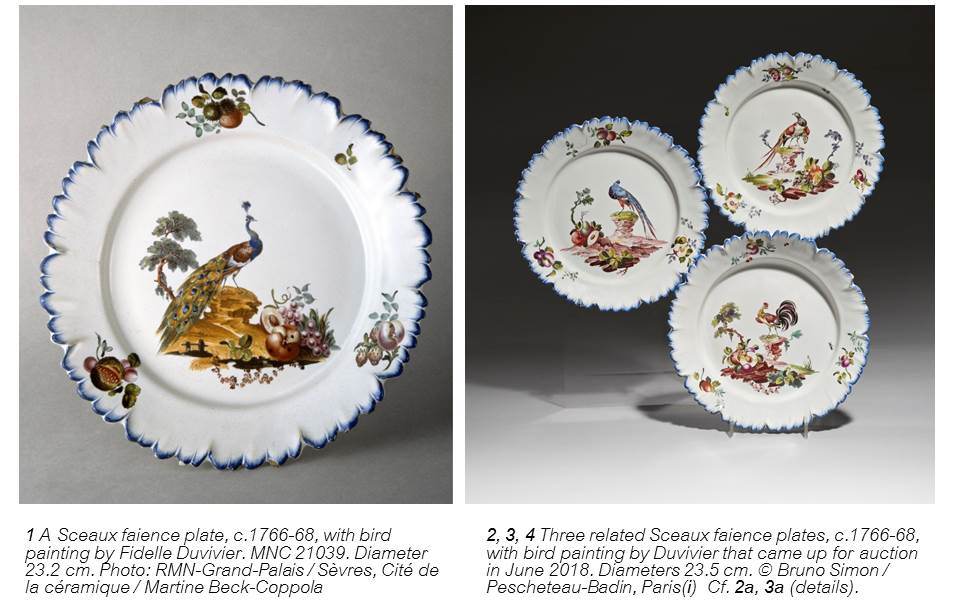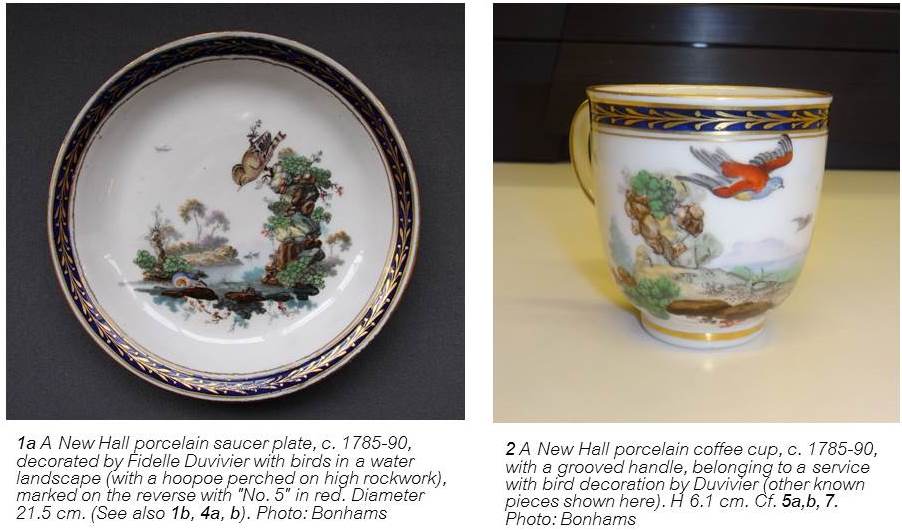
by Charlotte Jacob-Hanson | Jun 26, 2019 | Uncategorized
A number of Sceaux faience plates with Duvivier’s striking bird decoration have appeared recently on the French auction market and are shown here along with three related examples of this type (1, 5, 6) first ascribed to his hand in In the Footsteps of Fidelle Duvivier (2016).(ii)

by Charlotte Jacob-Hanson | May 10, 2019 | Uncategorized
While perusing the online collections of the National Trust I came across the images of a small Mennecy jug (2, 3) whose decoration immediately reminded me of another one of this manufactory, also painted by Fidelle Duvivier with little cupids on clouds (4). It was the earliest example of this type of decoration by Duvivier that I’d found, and I included it in my book.(i) This second example (at Hinton Ampner House, 1) is equally important, and I became curious to know who its owner was and more about its present home.

by Charlotte Jacob-Hanson | Mar 5, 2019 | Uncategorized
When Fidelle Duvivier returned to France to work at Sceaux for the second time he was a young man in his early thirties. He had with him his English wife Elizabeth (née Thomas), who was soon to give birth to their second child, a girl, on February 20, 1775.(i) The child’s baptism was recorded in the registry of the Catholic church of Saint Jean-Baptiste, and is the only documentation we have of the family’s presence in Sceaux. Prior to their arrival, Duvivier had signed a four-year contract to work for William Duesbury of Derby beginning in late 1769, and he had done much putto (cherub) decoration with little winged allegorical amours on clouds in the popular French style of François Boucher. He was therefore well prepared to do similar decoration on Sceaux porcelain (2a, 2b) of the Glot period (1772 – c. 1794), as the examples here demonstrate.

by Charlotte Jacob-Hanson | Jan 3, 2019 | Uncategorized
Ever since beginning to investigate Duvivier’s decorative work on Sceaux faience and porcelain, I have marveled at what an accomplished bird painter he was – both during his time in France, and again, about twenty years later in England.
It would not have been possible to identify his earlier French work without having the helpful stock of “reference images” provided by one particular New Hall part-service with bird decoration (3), which fortunately still exists intact in a private collection. A careful study of these images revealed a number of stylistic details (e.g. in the bird poses and rendering of vegetation) that originated in his French work and carried over into his later bird painting. But here we’ll turn our attention to a second, lesser known, New Hall bird service that Duvivier decorated, with surviving pieces preserved in a few private and museum collections.

by Charlotte Jacob-Hanson | Nov 30, 2018 | Uncategorized
This unusual Worcester plate was one of the four so-called “Grubbe plates” given to the Victoria and Albert Museum in 1935 by Mrs. Dora Edgell Grubbe in memory of her husband, Walter John Grubbe(i). He was a direct descendant of James Giles, the London china retailer and owner of the leading decorating establishment, whose employees decorated a great quantity of Worcester porcelain between 1767 and 1776. Fidelle Duvivier appears to have worked for Giles as an independent decorator either prior to or during the same period that he was employed by William Duesbury of Derby (1769-1773?). With its very French-looking decoration this plate has been tentatively attributed to Duvivier in the past, but just where the decoration comes from and how it fits in place as a piece of Duvivier’s story are explained in my book.(ii)

by Charlotte Jacob-Hanson | Sep 30, 2018 | Uncategorized
Not long ago several pictures of this very unusual Loosdrecht vase (auctioned in England in 2014) were sent to me by its present owner. A rare and curious vase, indeed, for its painted decoration, done by Fidelle Duvivier. We see a draped putto or child holding up a ribbon from which a bat hangs with its wings extended. The vase is unmistakably neoclassical in style, but what is the bat meant to signify in this decoration?






